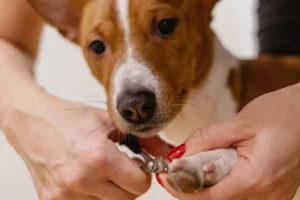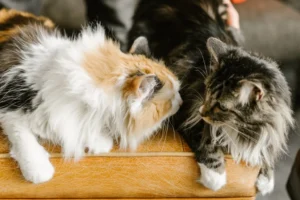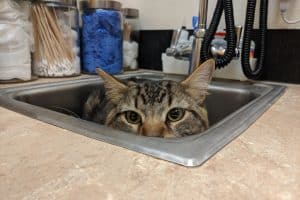Cats are beloved pets in many households, but their presence can pose a risk to babies. Understanding why cats are dangerous to babies is essential for keeping little ones safe.
Scratching and Biting Risks
Cats, while lovable companions, can pose potential risks to babies through scratching and biting. Their natural instincts, like hunting and play, may inadvertently lead to scratches or bites when interacting with infants. To prevent these risks, it’s crucial to supervise any interactions between cats and babies closely. Additionally, trimming a cat’s nails regularly can help reduce the likelihood of scratches.
If a cat starts to show signs of aggression or discomfort around a baby, it’s essential to separate them and seek guidance from a veterinarian or animal behaviorist. Training the cat to associate positive experiences with the baby’s presence can also help minimize the risk of scratching or biting incidents.
Allergies and Respiratory Issues
Another potential concern when it comes to cats and babies is the possibility of triggering allergies and respiratory issues. Cats produce proteins that can cause allergic reactions in some individuals, including infants. If a baby shows symptoms such as frequent sneezing, coughing, or skin rashes, it’s essential to consult a pediatrician to determine if allergies are the cause.
To manage allergies and respiratory issues related to cats, consider creating designated cat-free zones in the home, such as the baby’s bedroom. Regularly cleaning and vacuuming to minimize the presence of cat dander can also help reduce the risk of triggering allergic reactions in babies.
In addition to these precautions, introducing an air purifier with a HEPA filter can help improve indoor air quality and reduce allergens. It’s crucial to prioritize the baby’s health and well-being by staying vigilant and proactive in managing any potential allergy or respiratory concerns related to cats.
Litter Box Dangers
Cats’ litter boxes can pose potential risks to babies due to the presence of harmful bacteria and parasites. To minimize these risks, ensure that the litter box is placed in an area inaccessible to the baby. Additionally, always clean the litter box regularly and thoroughly wash your hands after handling it.
Moreover, be cautious with your cat’s waste disposal, as parasites like Toxoplasma gondii found in cat feces can lead to serious health issues in infants. Pregnant women should especially avoid cleaning litter boxes to prevent transmission of this parasite to the unborn child.
By practicing good hygiene and proper litter box management, you can significantly reduce the risk of infections and parasites spreading to your baby.
Additional Unique Insight:
Consider using covered litter boxes to contain odors and minimize the spread of bacteria around your home.
Carrying Diseases
Cats can carry diseases that are transmissible to babies, highlighting the importance of proper hygiene and veterinary care. Regularly visit the vet to ensure your cat is healthy and up to date on vaccinations to prevent the spread of diseases.
Maintaining a clean environment by regularly cleaning and disinfecting areas your cat frequents can also help reduce the risk of disease transmission. Encourage handwashing after interacting with your cat or cleaning its litter box to prevent the spread of germs to your baby.
It’s crucial to be proactive in monitoring your cat’s health and taking preventive measures to safeguard your baby from potential illnesses.
- Regular vet check-ups: Ensure your cat receives routine vaccinations and check-ups to prevent the transmission of diseases.
- Hygiene practices: Wash your hands after handling your cat or cleaning its litter box to minimize the risk of spreading germs to your baby.
- Clean environment: Regularly clean and disinfect your home to reduce the presence of harmful bacteria and viruses.
By following these tips, you can create a safer environment for your baby and cat to coexist harmoniously.
Sleeping Risks
Having cats sleep near or on babies can pose serious dangers, such as the risk of suffocation. Cats may inadvertently cover a baby’s nose or mouth while seeking warmth, leading to potentially life-threatening situations. To ensure a safe sleep environment, it’s crucial to create a separate sleeping space for babies away from cats. Invest in a sturdy crib with a fitted sheet and avoid placing any loose bedding or soft items that could obstruct a baby’s breathing. Additionally, consider using a baby monitor to keep an eye on your little one while they rest peacefully.
Tail and Fur Hazards
Cats’ tails and fur can present hazards around babies, including choking risks and allergen exposure. Infants may grab onto a cat’s tail, leading to accidental choking or injury. To manage this risk, it’s essential to supervise interactions between cats and babies closely. Keep cats’ tails out of reach and teach older children to handle cats gently and responsibly. Moreover, frequent grooming and vacuuming can help reduce allergens in the home, promoting a healthier environment for both babies and pets.
Tips for Managing Tail and Fur Hazards: 1. Trim your cat’s nails regularly to minimize scratching incidents. 2. Provide designated areas for cats to groom themselves, reducing loose fur in living spaces. 3. Consult with a veterinarian about appropriate grooming techniques and products to keep your cat clean and healthy. 4. Use lint rollers or pet-specific cleaning tools to remove stray fur from baby equipment and furniture. 5. Stay informed about common allergens associated with cats and take necessary precautions to minimize exposure.
Introducing Cats to Babies Safely
Bringing a new baby home is a big adjustment for everyone, including your feline friend. To ensure a smooth transition and prevent any potential dangers, it’s crucial to introduce your cat to your baby in a gradual and safe manner. Start by setting up a designated safe space for your cat where they can retreat to when feeling overwhelmed. Allow your cat to sniff and explore items that belong to the baby, such as blankets or clothing, to familiarize themselves with the new scent. When it’s time for the face-to-face introduction, supervise the interaction closely and always prioritize your baby’s safety.
Supervision and Boundaries
Supervision is key when it comes to ensuring the safety of both your baby and your cat. Always keep a close eye on any interactions between your feline friend and your little one. Establish clear boundaries, such as keeping the cat out of the nursery or using baby gates to create separate areas for each. Encourage positive interactions by rewarding your cat for calm and gentle behavior around the baby. Remember, with proper supervision and clear boundaries, cats and babies can coexist safely and even form a bond over time.
Important Tip: Ensure your cat has access to high spaces like shelves or cat trees to escape if they feel overwhelmed by the baby’s presence. Creating vertical space can help reduce stress for your cat and prevent potential conflicts.
Interesting Fact: Cats and Newborns
Did you know that cats are naturally drawn to the warmth and smell of newborn babies? This can lead to cats trying to cuddle up with infants, posing a potential danger due to their instinctual behaviors.
Cats have a tendency to knead or paw at soft surfaces, which can inadvertently harm a baby’s delicate skin. Additionally, cats may also try to nestle near a baby’s face, potentially creating a risk of suffocation.
Potential Health Risks
When it comes to cats and newborns, it’s crucial to be aware of potential health risks. Cats are known to carry bacteria in their claws and mouths, which could lead to infections if a cat scratches or bites a baby.
Furthermore, cats are carriers of toxoplasmosis, a parasite that can be harmful to infants if transmitted. Pregnant women are often advised to avoid cleaning litter boxes due to the risk of exposure to this parasite.
While it’s rare for cats to intentionally harm babies, it’s essential to supervise their interactions closely and take necessary precautions to ensure the safety of both the baby and the cat.
Alex, a passionate animal lover, has experience in training and understanding animal behavior. As a proud pet parent to two dogs and three cats, he founded AnimalReport.net to share insights from animal experts and expand his knowledge of the animal kingdom.









